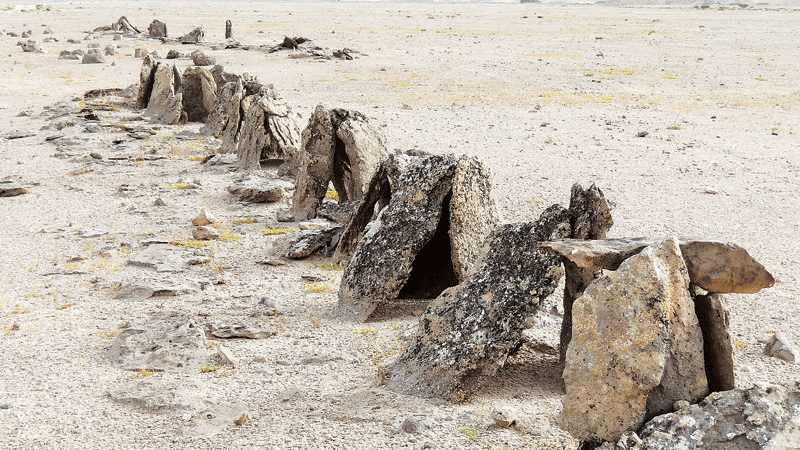


Khamis al Asni[/caption]
OMAN’S long history follows a rich archaeological record. Now, the archaeologists are trying to reveal the mystery of 2,000 year-old ritual stone monuments in the Sultanate.
The Ministry of Heritage and Tourism together with a team of archaeologists from the Czech Republic, Italy, Austria and Jordan is conducting research on the study of ‘Triliths’, the Iron Age ritual stone monuments.
Trilith monuments are distributed in the landscape throughout south-eastern Arabia from Hadramawt in Yemen up to Ras al Hadd.
They consist of three upright flat stones, angled inward to form a pyramid, and are often arranged in rows alongside dry watercourses.
Research which began in late 2018 is still undergoing but was postponed towards the end of 2020 till next year due to COVID-19.
The trilith’s stone compositions with hearths mark a space of special meaning which the archeologists still are unable to comprehend. They were probably ritual monuments of ancient nomads.
The archaeological team members consist of Roman Garba and Maria Pia Maiorano from the University L’Orientale Naples, Italy, Denis Stefanisko and Dominik Chlachula from the Masaryk University Brno, Czech Republic, Alzbeta Danielisova and David Danecek from the Archaeological Institute of the Czech Academy of Sciences, Jakub Trubac from the Charles University, Prague, Czech Republic and Omani Waleed al Ghafri from the Ministry of Heritage and Tourism.
The team is complemented by the geochronologists Stephanie Neuhuber from BOKU University Vienna, Austria, and Jordanian Mahmoud Abbas from the China University of Geosciences.
Triliths are also associated with large round fireplaces. Archaeologists have recorded more than 441 locations in Oman where such enigmatic stone compositions exist.
Although they appear to mark places of special meaning for ancient rituals, further interpretation is still a mystery as no human remains or other artefacts have been found near or beneath the trilith monuments.

Sultan-Saif-Al-Bakri[/caption]
“One of the main task of our archaeological expedition was excavation of trilith fireplaces across Oman for collection of pieces of charcoal suitable for radiocarbon dating to be able to tell when trilith rituals were performed,” says Roman Garba, Director of TSMO (Trilith Stone Monuments of Oman) archaeological expedition.
The first results from the excavated fireplaces shows that trilith monuments appeared 2,400 years ago and were used until 1,800 years ago.
This is 200 years earlier than previously archaeologists assumed. Expedition also discovered locations with two generations of trilith monuments where radiocarbon dates show 400 years between these generations.
Research on triliths is mainly conducted in Duqm where TSMO expedition has its base.
“The area surrounding modern port of Duqm is a unique cultural landscape providing evidence for human occupation from the Palaeolithic period until the Late Iron Age and there is one of the highest concentration of trilith monuments in Oman as well,” adds Waleed al Ghafri, an Omani archaeologist.
The TSMO expedition also made two additional discoveries in Duqm.
The first was the ancient coastal settlement beside lagoon in the area with high concentration of trilith monuments.
The collected bronze artefacts and charcoal samples provided evidence of human occupation starting from the Early Iron Age period (2,800 to 2,300 years ago).
“Any chronological convergence could have, indeed, a major contribution to the understanding of triliths’ function, particularly in the Duqm area,” says Maria Pia Mairorano.
The second discovery was the stone tools made 70,000 to 100,000 years ago, indicating one of the routes of modern humans spread Out of Africa to the rest of the world.
“A preliminary typological analysis of a recorded artefacts allowed us to date provisionally these surface finds to the Middle Palaeolithic period with indication of Levallois technique,” explains Denis Stefanisko.

The National Museum.
The trilith group from Wadi Sayy in Duqm was documented in 3D, excavated and all stones carefully labelled and wrapped. The dismantled monument, weighing nearly 900 kilogrammes, was transported 600 km to The National Museum of Oman in Muscat and reconstructed for the permanent exhibit.
“I am glad that we are contributing to the education of the wider public and preserve part of Omani heritage for future generations,” says Sultan al Bakri Director-General for Archaeology at the Ministry of Heritage and Tourism.
“The TSMO research project is the first dedicated research on trilith monuments of Oman and discoveries in Duqm shows potential for heritage tourism in the area,” concludes Khamis al Asmi, Director of the Department of Excavations and Archaeological Studies.
As soon as COVID-19 pandemic situation dies down, the archaeologists will continue working on unlocking the mystery of trilith monuments in Oman.
Liju Cherian
@Cherianmathiker
Oman Observer is now on the WhatsApp channel. Click here



